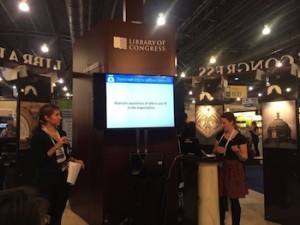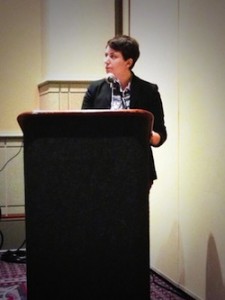The following is a guest post by Julia Blase, National Digital Stewardship Resident at the National Security Archive.

Julia Blase and Emily Reynolds present on “Developing Sustainable Digital Archive Systems.” Photo by Jaime McCurry.
In case you hadn’t heard, the ALA Midwinter Meeting took place in Philadelphia last weekend, attended by around 12,000 librarians and exhibitors. If you didn’t attend, or didn’t have friends there to take notes for you, the Twitter hashtag #alamw14 has it covered – enough content for days of exploration! If you’d like to narrow your gaze, and in the theme of this post, you could refine your search for tweets containing both #alamw14 and #NDSR, because the National Digital Stewardship Residents were there in force, attending and presenting.
Sessions Attended
Emily Reynolds, the Resident at the World Bank, was so kind as to compile a list of the sessions we aimed to attend before the conference. On Saturday, though none of us made it to every event, at least a few of us were at the Preservation Administrators Interest Group, Scholarly Communications Interest Group, Digital Conversion Interest Group, Digital Special Collections Discussion Group and Challenges of Gender Issues in Technology sessions.
The first session I attended, along with Lauren Work and Jaime McCurry, was the Digital Conversion Interest Group session, where we heard fantastic updates on audiovisual digital conversion practices and projects from the American Folklife Center, the American Philosophical Society library, Columbia University Libraries and George Blood Audio and Video. I particularly enjoyed hearing about the successful APS attempt to digitize audio samples of Native American languages, many of which are endangered and the positive reaction from the Native community. For audio, it seemed, sometimes digitization is the best form of preservation!
The second session I attended, with Emily Reynolds and Lauren Work, was the Gender Issues in Technology discussion group (see news for it at #libtechgender). We were surprised, but pleased, at the number of attendees and quality of the discussion around ways to improve diversity in the profession. Among the suggestions we heard were to include diverse staff members on search committees, to monitor the language within your own organization when you review candidates to ensure that code words like “gravitas” (meaning “male,” according to the panelists) aren’t being used to exclude groups of candidates, to put codes of conduct into place to help remind everyone of a policy of inclusiveness, and to encourage employees to respond positively to mentorship requests, especially from members of minority groups (women, non-white, not traditionally gendered). The discussion seemed to us to be a piece of a much larger, evolving, and extended conversation that we were glad to see happening in our professional community!
NDSR Presentations

Erica Titkemeyer presents on preserving time-based media art at the Smithsonian. Photo by Julia Blase.
On Sunday, though a few of us squeezed in a session or two, our primary focus was our individual project update presentations, given at the Digital Preservation Interest Group morning session, and also our extended project or topic presentations at the Library of Congress booth in the early afternoon. The individual presentations, I’m please to say, went very well! It would be impossible to recap each presentation here, however, many of us have posted project updates recently, so please be sure to look us up for details. Furthermore, searching Twitter for #alamw14 and #NDSR brings you to this list, in which you can find representative samples of the highlights from our individual presentations.
Presentations – Question and Answer Session
We concluded the session by taking some questions, all of which were excellent – particularly the one from Howard Besser, who wanted to know how we believed our projects (or any resident or fellowship temporary project) could be carried on at the conclusion of our project term. The general response was that we are doing our best to ensure they are continued by integrating the projects, and ourselves, into the general workflows of our organizations – keeping all stakeholders informed from an early stage of our progress, finding support from other divisions, and documenting all of our decisions so that any action may be picked up again as easily as possible.
We also had an excellent question about how important networking had been for the success of our projects, and all agreed that, while networking with the D.C. community has been essential (through our personal efforts and also through groups like the DCHDC meetup), almost more significant has been our ability to network with each other – to share feedback, resources, documents, websites, and connections to other networks, which has helped us accomplish our goals more efficiently and effectively. One of the goals of the NDSR program was, of course, to help institutions get valuable work done in the area of digital stewardship, which we are all doing. However, another goal was for the program to help build a professional community in digital stewardship. What is a community if not a group of diverse professionals who trust and rely on each other, who share successes and setbacks, resources and networks, and who support each other as we learn and grow? Though the language is my own, the sentiment is one I heard shared between us over and over during the ALA weekend.
NDSR Recent Activity
In recent news, Emily Reynolds and Lauren Work both discuss their take on our ALA experience, Emily’s here and Lauren’s here. Molly Swartz published some pictures and thoughts on ALA Midwinter over here. Jaime McCurry recently interviewed Maureen McCormick-Harlow about her work at the National Library of Medicine. And to conclude, I’ve recently posted two updates on my project, one on this page and another courtesy of the Digital Libraries Federation.
Thanks for listening, and be sure to tune in two weeks from now when Maureen McCormick-Harlow will be writing another NDSR guest post. If you, like us, were at ALA Midwinter last weekend, I hope you found it as enjoyable as we did!
